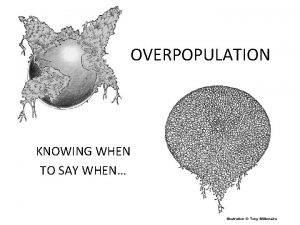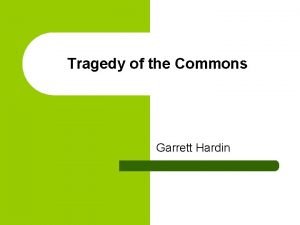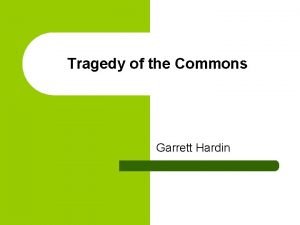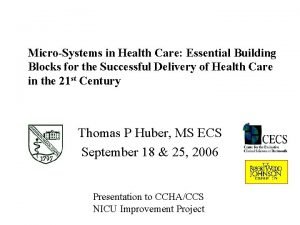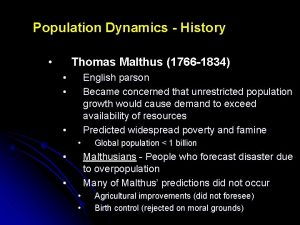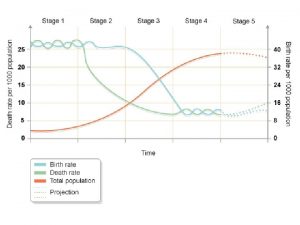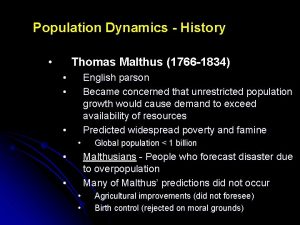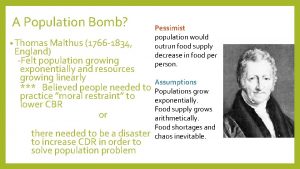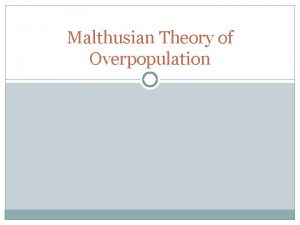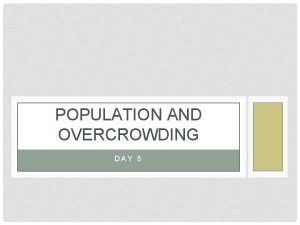Thomas Malthus 1766 1834 Economist who lived in






























- Slides: 30

Thomas Malthus (1766 -1834) • Economist who lived in England during the birth of the Industrial Revolution. • Noticed that the population was increasing rapidly as the death rate fell • Developed theory that the world was headed toward a population disaster- or, more specifically, a massive famine- because the population was increasing faster than the rate of food production.

1798

Thomas Malthus (1766 -1834) Malthus believed population rises geometrically, while food production rises arithmetically

Malthus’ disaster never happened, however. He lived while the Industrial Revolution was expanding across Europe and America, and assumed that the rate of pop’n increase would continue until crisis enveloped the planet. As we now know, however… Population growth would slow to a halt during later stages of the DEMOGRAPHIC TRANSITION.

Malthus’ fear of growing populations has not gone away. In the 1960 s, as the population of the developing world skyrocketed, people again began to worry about an impending disaster. These people were called NEO-MALTHUSIANS Paul Ehrlich’s book was a best-seller

Once again, however, the predictors of a global population nightmare were wrong. The effects of Stage 3 were becoming more apparent, with birthrates in developed countries falling, and it could then be assumed the same would eventually happen elsewhere. And like Malthus himself, the Neo-Malthusians underestimated the human ability to solve problems. The GREEN REVOLUTION- which we’ll study later- led to a massive expansion of agriculture.

A more optimistic approach • Ester Boserup (1910 -1999) • Wrote “The Conditions of Agricultural Growth” in 1965 • Opposite to Malthus • People have resources of knowledge and technology to increase food supply as necessary

Boserup’s main points • Environments have limits that restrict population • But these limits can be changed using technologies • Population growth is the trigger for innovation to allow food supply to increase • e. g. irrigation, weeding, crop intensification, better seed quality, tools, techniques etc

Was Boserup right? • Evidence which supports Boserup: – Increasing intensity of shifting cultivation – Move from ‘slash and burn’ practices to using irrigation in rural areas with higher population densities – The Green Revolution – widespread introduction of high-yielding varieties, pesticides etc – Hugely increased yields allowed more people to be fed – GMOs – Genetically Modified Organisms

Was Boserup right? • Boserup admits that overpopulation can lead to unsuitable farming practices which may degrade the land • E. g. population pressure as one of the reasons for desertification in the Sahel region

• Those who believe that humans have the capacity to overcome the challenges we face are believers in CORNUCOPIAN THEORY.


Natalist Policies Countries around the world face problems from populations that are either growing too fast, or which are slowly shrinking. Countries with LOW birthrates try to promote their people to procreate by instituting PRO -NATALIST POLICIES. Countries with HIGH birthrates try to curb the amount of children being born by instituting ANTI-NATALIST POLICIES.

Denmark, like many European countries, has a population in decline. To combat their low birthrate, the Danish government has funded a campaign called ‘Doing It for Denmark’

Singapore has a similar idea. NATIONAL NIGHT

India, however, has more than a billion people and a birthrate that remains very high. It will become the most populated country in the world in the coming years.

China in the 1970 s faced a population jumping into the billions. In order to curb the reproductive habits of its huge populace, its leaders created a controversial law. The ONE CHILD POLICY

UNDER THE ONE CHILD POLICY- • Couples had to APPLY to have a child. • Men could not marry until 22, women until 20. • Having only one child would result in increased social benefits like money from the government, free food, or expanded opportunities. • Having a second child could result in massive fines and a reduction in these same social benefits. • Men and women could receive a large sum of money for undergoing sterilization.

‘Little Emperor’ Syndrome

Epidemiologic Transition � Identifies distinct health threats in each stage of the Demographic Transition.

Stage 1 – Pestilence and Famine (High CDR) �During stage one most deaths occur due to infectious or parasitic diseases, or from environmental factors like floods or earthquakes.

The BLACK PLAGUE is the deadliest of the Stage 1 epidemics; more than HALF of Europe died- IN THREE YEARS. It was spread by fleas carried by rats on ships, so port citiers were the first to fall victim.

Stage 2 – Receding Pandemics (High CBR, Low CDR) sanitation, nutrition, and medicine �Improved leads to a reduction in epidemics, and overall death rates plummet.

John Snow’s Cholera Study (1854)

Stage 3 – Degenerative Diseases (Low CBR & CDR) �During Stage 3, people are living longer than ever before and chronic diseases associated with age begin to be society’s greatest health challenge.


Stage 4 – Delayed Degenerative Diseases (Low CBR, Low but increasing CDR) �Deaths caused by cardiovascular diseases, cancer, and other progressive diseases delayed because of modern medical technology and treatments.

�Because of the epidemiologic transition, health patterns are very different in the developed and developing world.

Stage 4 problems. CANCER RATES

Stage 4 problems. OBESITY RATES
 Thomas robert malthus (1766-1834)
Thomas robert malthus (1766-1834) Thomas malthus industrial revolution
Thomas malthus industrial revolution Thomas robert malthus
Thomas robert malthus Thomas malthus overpopulation
Thomas malthus overpopulation Thomas malthus carrying capacity
Thomas malthus carrying capacity David ricardo and thomas malthus
David ricardo and thomas malthus Malthusian theory
Malthusian theory Geophenom
Geophenom Biografia de robert malthus
Biografia de robert malthus Malthus
Malthus Malthus rant
Malthus rant 1834 poor law
1834 poor law 1834-1839
1834-1839 1923cmp
1923cmp Constitución de 1834 del perú
Constitución de 1834 del perú It must be love of fatherland that governs
It must be love of fatherland that governs 1834 zollverein
1834 zollverein Rete kustassoo
Rete kustassoo 1834-1478
1834-1478 Refrigerador 1834
Refrigerador 1834 Thinking like an economist ppt
Thinking like an economist ppt Tragedy of the commons adalah
Tragedy of the commons adalah What does the cartoon imply about the open door policy
What does the cartoon imply about the open door policy Thinking like an economist chapter 2
Thinking like an economist chapter 2 Thinking like an economist chapter 2
Thinking like an economist chapter 2 Economist.com
Economist.com Pareto economist
Pareto economist Tragedy of the commens
Tragedy of the commens Thinking like an economist chapter 2
Thinking like an economist chapter 2 Microsystem examples
Microsystem examples Economist.com
Economist.com

